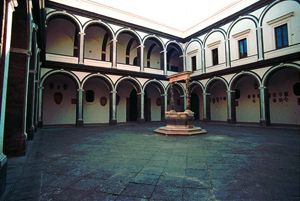
The National Museum of S. Martino is Naples’ most varied and surprising museum; rich in artistic beauty, curiosity and various elements of style, it offers a marvellous panorama from its windows and terraces. Built on the hill of the Vomero, at the foot of the Castle of S. Elmo, it contains an 18th century church with its various sacristies, which are rich in the works of art, so that it is almost a gallery of Neapolitan art of its times. A fine cloister, the work of Cosimo Fanzago, other small cloisters, long rooms which record the history of Naples, models of ships, festive coaches, jewellery, records of the theatre of Pulcinella, folk costumes and uniforms, Abruzzo majolica, the shepherds from the cribs etc., are among the collections to be found here. A discerning visitor may pass many an hour there, scrutinising the showcases, discovering details in the decorations of the rooms themselves, admiring the glimpses of the landscape which change from every window as far as the great balcony from which one may enjoy the view of the whole city from Capodimonte to Posillipo: the famous balcony overhanging the Bay. It was an old monastery, built in the 14th century, but its present style is Baroque. Fanzago worked there for many years, and all Naples’ artists, or those who worked there in those times, have left their mark on S. Martino. In 1860 the Carthusians had to leave the Monastery, after the laws suppressing religious orders, and from that time it has been a museum, slowly growing and developing, in a surprising way, throughout the cells, corridors and room of every size, with their ever-changing vistas.
THE CRIB OF NAPLES
Actually, the crib was not born in Naples: the first one was in fact made by S. Francis with living persons in the Grotto of Gubbio. But in Naples the crib took on a particular significance, for it assumed a realistic effect by its introduction of contemporary life into the mystic scene. The 18th century saw the triumph of the baroque and gave the crib rich decorative elements that often aspire to art Sculptors of renown such as Sammartino, the creator of “Christ Veiled” in the Chapel of Sansevero, Vassallo, Gori, Celbrano, left their great marble statues to model , one by one, the little terracotta figures with glass eyes, which represent the countrymen, washerwomen, drovers, hawkers and animals of the courtyard. Their models were chosen from the people, the vivacious Neapolitans of that day. And so whole streets of Naples were transferred to the cribs, with beggars, local characters and people in their 18th century costumes that could have no historical connection with the scene at Bethlehem. But it is that fully known anachronism that has given beauty to the Neapolitan crib, offering a wonderful blossoming of truth and fantasy to the Nativity scene, in a framework of the Spanish Viceroyalty and the kingdom of Charles of Bourbon.
King Charles himself arranged the crowd of shepherds on his personal crib, and his queen, Amalia, sewed the shepherd’s clothes with her own hands, while a host of jewellers, woodcarvers, instrument makers and potters created a world of minituare objects to suit the little characters. Thus, every Neapolitan household wanted its own crib, and many of them are still preserved by poetic, devoted collectors. The largest crib in the world is that of the Museum of S. Martino, which is like a catalogue of the shepherds of the most famous artists.
But the admirer must not neglect the precious little private museum of the Catello collection in Via Cimarosa, and he may request Count Leonetti, avv. Perrone and other noted collectors for permission to visit their collections. Other famous cribs are the one in marble in the Church of Monteoliveto, and the one in wood in S.Giovanni a Carbonara; but at Christmas time almost all the Churches have their own enchanting cribs.